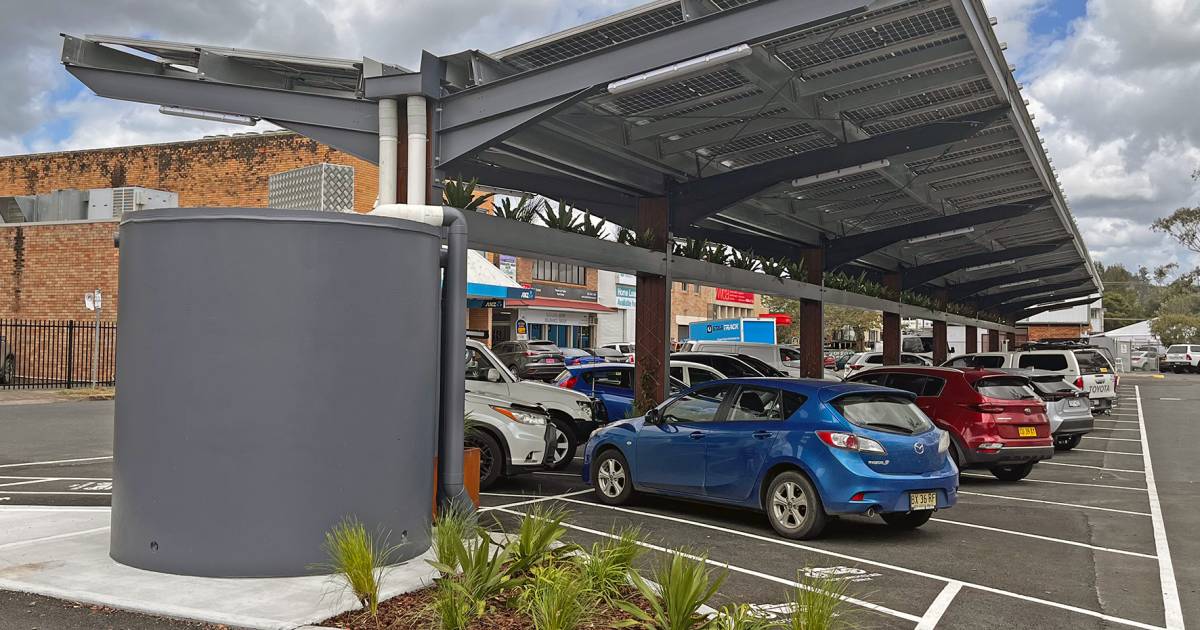
Lismore City Council’s Clyde Campbell solar carpark is providing shade for shoppers, generating clean electricity and charging electric vehicles.
The $650,000 solar carpark project was funded through a $1 million grant provided by the Federal Government’s Drought Communities Program. It features a roof boasting 99.68kW of solar panels providing shade to 32 public carparks, two accessible car parks, four motorcycle parks and two electric vehicle charging spaces.
EV owners will be able to top up their electric cars using the Chargefox system at a cost of 40 cents per kilowatt-hour. It was anticipated charging services would be available from last Friday afternoon.
224 x 445W bifacial solar panels have been used for the arrays, which was an interesting choice. A bifacial solar panel is a type of PV module that can make use of light hitting the rear as well as the front face.
Another interesting aspect is the butterfly-type layout of the panels. This was inspired by the native Richmond Birdwing Butterfly. Birdwing Butterfly vine, its food source, is to grow on the shade structure from hanging planter boxes.
“This project demonstrates Council’s forward-thinking approach to building a more sustainable future,” said Lismore City Council General Manager John Walker. “The addition of an EV charging station along with more shaded parking in the CBD will be a great asset to the city.”
Construction of the project officially kicked off in early July with electrical work for the 75kW DC fast EV charger and resurfacing of the area. Originally scheduled to be completed by late October, delays were experienced while awaiting Essential Energy’s nod on switchboard design, which had some knock-on effects also holding up other aspects.
What About Future Flooding?
Resurfacing and repairs to the car park area were necessary after a major flooding event in February this year. It was an event Lismore residents won’t forget, and some raised it in relation to this project. Regarding the potential for similar flooding in the future (here’s hoping that never happens) and the impact on the solar carpark, Council said it was a major consideration during the design phase.
“All electronic/electrical components are positioned above the 1% AEP flood level of 12.45 AHD (the level specific to this location) or are removable (the EV charger). The solar roof of the structure includes an extra 500mm of ‘freeboard’ so the lowest solar panels sit at approx. 12.95 AHD. Furthermore, the structure itself has been engineered to withstand these flood depths and velocities, including an allowance for debris build up.”
Small-scale Solar Power In Lismore
The Clyde Campbell carpark PV projects adds to a bunch of other small-scale systems (<100kW capacity) in Lismore, where solar panels are a common sight on the rooftops of homes and other buildings. As at the end of November, more than 10,435 small-scale systems had been installed in Lismore’s postcode area (2480), with a collective capacity of 54,184 kW.
For households and businesses in the area still without panels, there are some great solar installers servicing Lismore that can help them start slashing their electricity bills through harvesting clean energy from their rooftops.

 RSS - Posts
RSS - Posts



I am a Lismore area resident. I submitted feedback before physical work started on this project, in that the 12.95M was nowhere near safe for possible future floods. (The last horrific flood height was 14.4M, & the theoretical maximum is 16M). I am worried that there might be no protection incorporated to ensure system safety even with the electronics removed because the end-to-end voltage could be higher than 600v. If a flood victim landed on the solar array, even when it was underwater, there is a possibility of electrocution. There is a way to render these systems safe with a module made locally by CQ in Brisbane. (I think all series solar arrays in flood areas should use a safety device such a this). The other issue is with panel retention once the system is totally underwater. The Clyde Campbell carpark is a floodway, so high velocity water is a given.
The design criteria was definitely flawed for this project. I own 2 flats in Lismore, built 6 yrs ago, at 12.9M floor height. The last flood went through just under the fans… If I had known about the 16M potential, I would not have built this project.
I have no affiliation with CQ Electronics, but saw their product at the All-Energy Expo in Melb some years ago. (or one of the other Expos I have attended).
btw, I am in favor of the EV charger in Lismore (much needed). However I feel it should have been installed out of flood-zone. Other towns in Australia should also consider flood issues as well, I feel.
regards, Doug
All very good points. I know the area well having grown up on the Clarence with a Lismore as the nearest large commercial centre although Casino seems to be edging ahead in aftermath of the flooding . I think 16M is a conservative but sensible consideration which obviously rules out majority of the town as flood safe. However, after witnessing the flooding last year and seeing the 1974 flood markers around town, it will certainly happy again. Worth considering when installing or rehousing commercial electrical equipment.
I’ll plug in my Tesla for a top-up next time I’m in town.